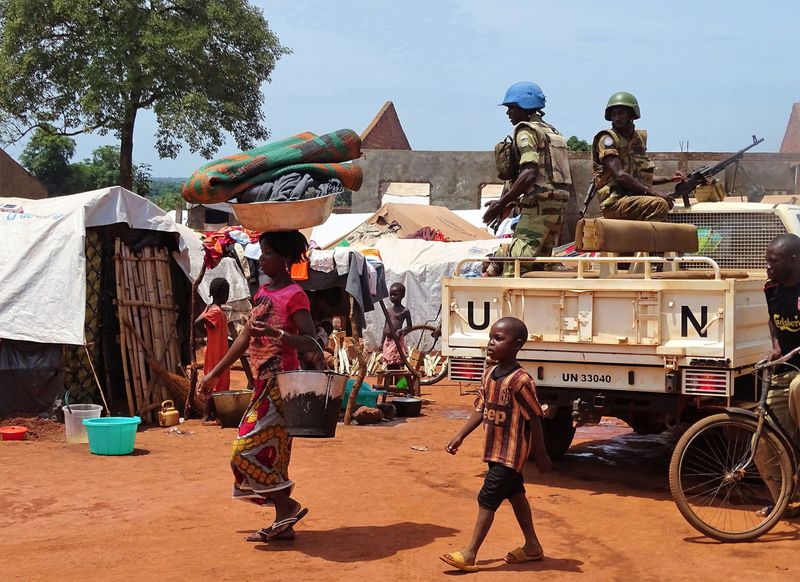Rough diamonds enabled Abdoul Raouf to marry three women and put his nine children through school. Now that his town in western Central African Republic can legally export the gems to world markets again, his neighbors are expecting similar fortunes.
“Diamonds are my life,” said Raouf, who trades the stones bought from artisanal miners in the town of Gamboula, near the border with Cameroon and a 10-hour drive to the capital, Bangui. “It’s because of diamonds that I can take care of my family.”

Gamboula is one of five areas in the west that can freely trade in diamonds again after the gradual easing of an export ban imposed three years ago. While fighting has flared in the southeast, forcing tens of thousands to flee, the western Mambere-Kadei prefecture has embraced a tentative peace, enabling residents to return to the diamond sites.
The government estimates that at least 20 percent of the population in the west, or about 60,000 people, earn an income from diamond mining. It’s not unusual to see children skip school to accompany their parents and help them sift gravel to search for the gems.
“The partial lifting of the embargo has been very important for the government, enabling us to collect taxes and strengthen the state coffers,” Mining Minister Leopold Mboli-Fatrane said in an interview in Bangui.
Green Zones
In May 2013, several months after an alliance of mainly Muslim insurgents seized power, the Central African Republic was suspended from the Kimberley Process, an international group representing the industry, civil society and governments that seeks to halt the sale of diamonds from war zones. This meant that the country could no longer export the gems, even as buying houses could still purchase and store them locally.
Until the embargo, diamonds were the country’s biggest export, with annual production capacity estimated at 840,000 carats, according to the organization. The United Arab Emirates is an important buyer.
As fighting subsided in the west, the Kimberley Process last year proposed a partial lifting of the blanket suspension to allow diamond exports from so-called green zones while keeping the ban in force in regions where fighting continues and diamonds are likely to fall into the hands of militia. The first town to start trading internationally again was Berberati, in the prefecture of Mambere-Kadei, in May 2016.
Mambere-Kadei is home to one of two main river systems in the Central African Republic that together hold an estimated 39 million carats in diamond reserves, according to the U.S. Geological Survey.
“We’ll continue to collaborate so that diamond exports can resume from the entire country, which is our hope,” Mining Minister Mboli-Fatrane said.
The government also cut the cost of a license for diamond collectors by more than 30 percent to 680,000 CFA francs ($1,200).
‘Black Market’
While Raouf, who is a Muslim, said armed groups have left Gamboula and that communities of different religious faiths get along well, the United Nations warned on July 18 that other parts of the country are wracked by violence on a scale not seen since 2014. Towns in the southeast have witnessed an upsurge of conflict, with rapes, kidnappings and violence against children, prompting some 60,000 people to seek refuge in the neighboring Democratic Republic of Congo.
As long as the armed groups in the country aren’t brought under control, the partial lifting of the export ban is likely to encourage smuggling as ‘legal’ diamonds from the west can easily be mixed with gems from elsewhere, Global Witness said in a report in June, citing evidence from traders who are selling via Facebook and WhatsApp.
“Smugglers and traders are thriving in the parallel black market,’’ the London-based advocacy group said. “The violent armed groups that still control large diamond-rich areas in the east, and the strongmen that retain influence in parts of the west, may still be profiting from diamonds that reach international markets with ease.’’
Mboli-Fatrane said the government doesn’t agree with the group’s accusations and considers lifting the embargo the best way to combat smuggling.
The Central African Republic ranked bottom of the list of 188 countries in the 2016 UN Human Development Index, which measures indicators such as income inequality and life expectancy. The conflict has forced a million people to flee their homes, while close to half of the population of 5.5 million needs humanitarian assistance, according to the Norwegian Refugee Council.
Many artisanal miners in the relatively peaceful western region still cross the border to neighboring Cameroon to sell their stones, said collector Raouf. “My wish is that we get more local buying offices in the area so that here will be less smuggling.”

